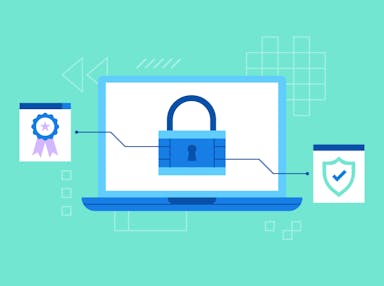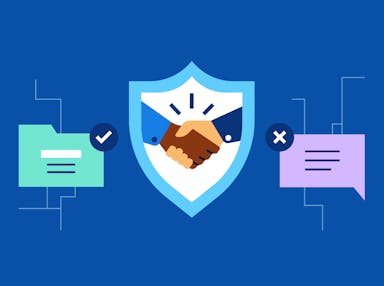
MDM 101: What Device Management Actually Means (and Why It’s a Great First Security Control)
Anne Maguire
Head of Growth Marketing at Zip Security
Marc Rubbinaccio
Head of Cybersecurity & Compliance
This article is written and contributed by Zip Security, a proud Secureframe partner.
For many teams, mobile device management starts as a series of manual workarounds. A new hire joins and someone scrambles to assemble a laptop. An employee leaves and you hope company data didn’t go with them. Security tools eventually get installed. It’s an informal system built on good intentions and duct tape.
That kind of approach works, until it doesn’t.
Eventually, something forces the issue: the company grows, a customer asks for a security review, a device gets lost, leadership wants visibility. Suddenly, the stakes are higher and the gaps become obvious.
While highly-experienced security professionals may know to invest in mature MDM offerings from the outset, we usually see this shift happen at one of two inflection points:
- Incident Response: A security incident, audit failure, or offboarding gone wrong exposes a lack of control.
- Compliance Certification: The company requires an industry certification whether it’s SOC 2, ISO 27001, HIPAA, or something else and needs to prove that devices are secure and policies are consistently enforced.
In all cases, the core need is the same: you can’t secure what you can’t control.
Recommended reading

8 Reasons Startups Fail Their Security Compliance Audit and How to Avoid Them
MDM enables positive control
That’s where mobile device management (MDM) comes in. It gives teams positive control over their device fleet: the ability to configure, monitor, and secure endpoints before anything goes wrong.
With MDM in place, you no longer have to guess which devices are in use, who is using them, whether they're secure, or if security policies are being followed. Every laptop, desktop, and mobile device is accounted for, configured to your standards, and continuously compliant.
Specifically, the right MDM solution enables you to:
- Maintain a real-time inventory of all devices in your environment
- Enforce baseline protections like disk encryption, firewalls, and device hardening
- Automate software installs, patches, and updates to reduce security vulnerabilities
- Detect and alert when devices drift from policy or fall out of compliance
- Remotely lock or wipe devices if they’re lost, stolen, or offboarded
This is the essence of positive control: you’re not reacting to problems after the fact - you’re managing proactively, with full visibility and the power to take action instantly.
Recommended Reading

How to Get Started with IT Asset Inventory Management
What MDM is (and what it is not)
Despite its growing adoption, MDM is still often misunderstood.
MDM is a lightweight, policy-driven control layer. It automates device setup, enforces security standards, and enables remote troubleshooting all without getting in the way of users.
MDM isn’t employee monitoring software. It doesn’t track keystrokes or collect personal data. It’s not a rigid lockdown system that restricts productivity.
In short, MDM is infrastructure, not surveillance. It exists to secure the device, without shackling the person behind it.

Security frameworks require MDM (even if they don’t say it)
Most compliance frameworks such as SOC 2, ISO 27001, HIPAA, and NIST CSF do not name MDM as an explicit requirement, but the criteria and outcomes expected make it a functional necessity. For example:
- Change management and change control aren’t just about documenting updates. These requirements ask how you push and validate configuration changes across your fleet. In practice, they are telling you that you need positive control over your devices.
- Access revocation means you must be able to instantly and remotely cut off access when someone leaves the company or a device is lost. That level of control is nearly impossible without MDM.
- Evidence of control requires you to show that policies like encryption, patching, and agent enforcement are active and verifiable. Screenshots and spreadsheets may be enough for a lightweight audit, but not for real security assurance.
These controls aren’t theoretical checkboxes, they are operational expectations. Without MDM, meeting them reliably is difficult to impossible. With MDM, they become routine.
Recommended reading

Understanding Security Frameworks: 14 Common Frameworks Explained
How MDM improves compliance
While implementing MDM is not a hard requirement for frameworks like SOC 2 and ISO 27001, they do have endpoint requirements that are difficult to monitor, control, and enforce compliance with without MDM software.
Instead of relying on manual screenshots, spreadsheets, or device-by-device checks, MDM provides centralized visibility and real-time reporting for endpoint security across your organization. That means when an auditor asks whether all company laptops have full-disk encryption enabled, for example, you can answer with confidence and provide evidence that’s already been generated by your MDM.
Pairing MDM with a compliance automation platform takes these benefits even further. Integrations allow device data from your MDM to automatically flow into your compliance platform, where this evidence can be mapped to controls and requirements for SOC 2, ISO 27001, HIPAA, PCI DSS, and more. This ensures endpoint security controls aren’t just implemented they’re continuously validated and audit-ready.
In short, MDM paired with compliance automation can enhance your security and compliance posture by shifting endpoint security from a reactive, manual process into a proactive, automated one.
Recommended reading

Mobile Device Management (MDM) Software & Its Role in a Security Compliance Program
How MDM powers the rest of your tech stack
Once MDM is in place, it becomes the foundation for other tools to execute and orchestrate their core functions. Security frameworks expect organizations to control and monitor devices, but most security tools can’t do that on their own.
Take Endpoint Detection and Response (EDR), for example. EDR solutions like CrowdStrike and SentinelOne are designed to monitor devices for cybersecurity threats, but they assume the device is already configured properly. If the agent fails to install, loses a critical permission, or is removed entirely, it often happens silently. Without MDM, these gaps go unnoticed, leaving you with a false sense of coverage.
MDM closes that gap. It provides the reach, permission structure, and orchestration layer for agents to deploy and run. It gives security teams visibility into which devices are protected, which aren’t, and why.
This same principle applies to other controls like identity enforcement, Zero Trust policies, or automated patching. These tools rely on real-time device data to make decisions. If that data is missing, outdated, or incomplete, those decisions can’t be trusted. MDM provides the source of truth that makes them work reliably.
Recommended reading

How to Build a Compliance Program that Meets Your Business Expansion Goals
How MDM streamlines IT operations
Beyond the security and compliance benefits, MDM can also have a positive impact on IT processes. MDM allows new hires to receive preconfigured devices out of the box, lets teams deploy apps remotely, and reduces time spent troubleshooting configuration issues. It ensures that departing employees can be offboarded quickly and securely, with access revoked and data wiped if needed.
These capabilities reduce overhead, improve consistency, and give IT teams the tools they need to manage devices at scale whether they’re supporting 20 endpoints or 2,000.
Recommended reading

A Guide to Onboarding and Offboarding Employees for Risk Prevention
Ready to get MDM right? How to pick the right MDM tool
The right MDM tool sets the foundation for scalable, reliable security. It should align with your environment today and support where you’re headed next.
Start with operating system support. Your MDM should match the devices your team actually uses - whether that’s macOS, Windows, or both. For Mac-heavy fleets, Jamf offers deep platform control. For Microsoft environments, Intune is a strong native option.
Beyond that, look for:
- Granular policy enforcement across encryption, firewall settings, and secure configurations
- Automated deployment and updates to reduce manual lift and enforce consistency
- Real-time visibility and drift detection so you can catch issues early
- Integrations with identity providers and EDR tools to connect device health with access and threat coverage
- Scalability to support your fleet and workflows as the company grows
- Integration with compliance automation platforms so you can pull in information about devices in your MDM instance to inform your security controls and simplify audit prep for SOC 2 and other frameworks
Teams that start with overly lightweight or low-cost tools often find themselves redoing the work later - spending valuable time and resources migrating to a platform that can actually meet their needs. Planning for scale early can save months of rework down the line.
Finally, your MDM is only as effective as its configuration. Even the best platform won’t help if policies aren’t applied, devices aren’t enrolled, or alerts go unmonitored. A solid rollout ensures you get the visibility and control you’re counting on from day one.
Recommended reading

5 Hardest Things About Security Compliance and How Technology Can Help
Why use Zip Security and Secureframe to automate MDM and compliance
Choosing the right MDM tool is only the start to building a robust security and compliance program. To maximize its impact, organizations need a way to ensure that the protections enforced on devices map directly to compliance requirements and remain consistent at scale.
That’s where automation tools like Zip Security and Secureframe come in. Zip Security automates the deployment, configuration, and management of MDM tools—enforcing best practices and providing visibility across the entire device fleet. Secureframe, in turn, integrates with those tools to automatically collect evidence of device management and validate controls and framework requirements related to endpoint security.
Together, they offer a comprehensive approach: Zip ensures devices are secured and policies are consistently applied, while Secureframe ensures that those policies and controls are continuously monitored, documented, and ready for auditors. The result is a stronger security posture, less manual effort, and faster time to compliance.
If you’re interested in learning more about how Secureframe’s agent and/or MDM integrations can help simplify compliance, book a demo with a product expert. You can also fill out this form to see how Zip can help you automate away your IT & cybersecurity grunt work.
Zip Security is an all-in-one IT and cybersecurity platform. We automate the deployment, configuration, and management of best-in-class security tools like MDM and EDR. Our opinionated software helps you get and stay compliant by enforcing best practices, automating remediation, and providing full visibility across your fleet.
Mobile device management, simplified.

Anne Maguire
Head of Growth Marketing at Zip Security
Anne Maguire is the Head of Growth Marketing at Zip Security, an all-in-one cybersecurity and IT platform that simplifies device, identity, and browser management for growing businesses. With a background in data-driven marketing and years of experience helping organizations strengthen their security posture, Anne is passionate about making mobile device management (MDM) accessible, proactive, and scalable for teams of all sizes.

Marc Rubbinaccio
Head of Cybersecurity & Compliance
Marc Rubbinaccio is an information security leader with over a decade of experience in cybersecurity. As a former auditor and security consultant, Marc performed and managed security and regulatory audits as a lead QSA. At Secureframe, he’s helped hundreds of customers achieve compliance with federal and commercial frameworks, including PCI DSS, SOC 2, ISO 27001, CMMC, and FedRAMP. He also played an integral role in Secureframe’s own CMMC Level 2 assessment and FedRAMP 20x Low authorization.